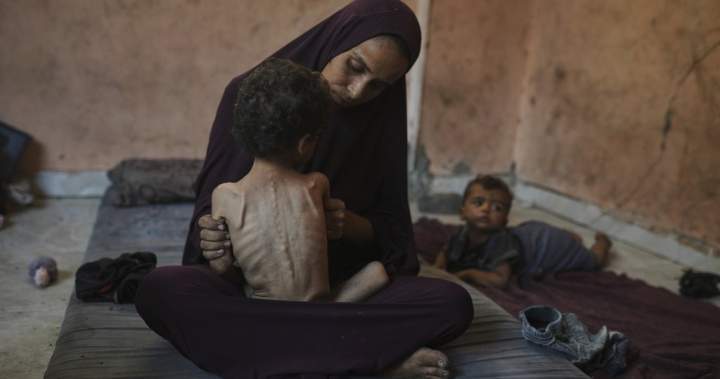I crossed the Rafah border yesterday as Egyptian authorities granted limited access to international press. The sight greeting me wasn’t just a humanitarian crisis – it was a complete collapse of civilization’s basic scaffolding.
“We haven’t seen clean water in days,” whispered Fatima al-Najjar, a mother of four sheltering in what remains of a school in central Gaza. Her youngest child, barely two, has developed a persistent rash that spreads across his tiny limbs – the consequence of bathing in brackish, contaminated water when any bathing happens at all.
The humanitarian catastrophe unfolding across Gaza has reached unprecedented levels, with the UN Relief and Works Agency (UNRWA) warning that 90% of Gaza’s 2.3 million residents now face severe food insecurity. This marks the highest percentage ever recorded in any global crisis assessment.
Walking through Deir al-Balah’s crowded streets, the infrastructure devastation is complete. Sewage flows openly between makeshift tents. Medical facilities operate by flashlight. The air carries the unmistakable scent of untreated waste and unburied bodies.
Dr. Mahmoud Salhab, performing surgery at Al-Aqsa Hospital with dwindling supplies, spoke between operations. “We’re rationing everything – anesthetics, antibiotics, even gauze. Yesterday I amputated a child’s leg using only local anesthesia. His screams will stay with me forever.”
The World Health Organization reports that 36 of Gaza’s 51 medical facilities are now completely non-functional. Those remaining operate at approximately 28% capacity, often without electricity or sufficient medical supplies.
Philippe Lazzarini, UNRWA Commissioner-General, stated last week that aid distribution has effectively collapsed across multiple sectors. “What we’re witnessing isn’t just a humanitarian crisis – it’s a profound human dignity crisis,” he told me during a brief satellite call. “Children are dying not just from bombs but from entirely preventable causes: diarrhea, malnutrition, simple infections that would require basic antibiotics.”
The economic dimensions extend beyond immediate suffering. The World Bank estimates Gaza’s infrastructure damage exceeds $18.5 billion – nearly four times Gaza’s annual GDP before the conflict began. Rebuilding, even under optimistic scenarios, would take decades.
American and European diplomatic sources, speaking on condition of anonymity, acknowledge frustration with the pace of ceasefire negotiations. “There’s a growing disconnect between what diplomats claim at press conferences and the glacial pace of actual progress,” explained a European diplomatic adviser in Cairo.
On my third day reporting from Gaza, I witnessed aid trucks idling at checkpoints for hours, sometimes days. “The bottlenecks aren’t just physical – they’re bureaucratic and political,” explained Mohammed Fares, a logistics coordinator for Oxfam. “By the time approval comes, the food has often spoiled.”
The International Committee of the Red Cross has documented concerning increases in waterborne diseases, particularly among children. Hepatitis A cases have increased seven-fold since January. Acute respiratory infections affect nearly 60% of children under five in displacement camps.
What distinguishes this crisis is the comprehensive breakdown across all sectors simultaneously – what aid workers call “cascading system failure.” Water systems, electricity, sanitation, healthcare, education, and food security have all collapsed simultaneously, creating compounding effects worse than the sum of individual failures.
Ceasefire negotiations continue in Doha and Cairo, but those I spoke with in Gaza express little faith in diplomatic solutions. “We’ve heard promises before,” said Ahmad Khalidi, a teacher now living in a tent with 23 relatives. “Meanwhile, my students haven’t attended school in almost a year.”
The psychological impact cannot be overlooked. UNICEF mental health specialists report alarming rates of trauma among Gaza’s children – over 80% show signs of severe psychological distress, including bedwetting, extreme withdrawal, and aggressive behavior.
“These children will carry this trauma for generations,” explained Dr. Leila Hamdan, a Palestinian psychologist working with displaced families. “Even if fighting stopped tomorrow, the mental health emergency would continue for decades.”
As night fell over Khan Younis, I watched families huddled around small fires, cooking what little food they had secured that day. The resilience was evident but stretched to breaking points I’ve rarely witnessed in twenty years covering conflicts.
The diplomatic impasse continues while ordinary Gazans pay the price. At the current trajectory, UN officials privately acknowledge they cannot prevent widespread famine conditions from developing across much of the territory within weeks.
Leaving Gaza through the same Rafah crossing where I entered, the contrast between diplomatic rhetoric and ground reality couldn’t be starker. The words “humanitarian crisis” fail to capture what Gaza has become – a place where humanity itself struggles to survive.






